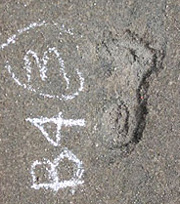 |
| People left traces
of their presence in the sediments of a shoreline
| |
Human settlers made it to the Americas 30,000 years earlier than
previously thought, according to new evidence.
A team of scientists came to this controversial conclusion by dating
human footprints preserved by volcanic ash in an abandoned quarry in
Mexico.
They say the first Americans may have arrived by sea, rather than by
foot.
The traditional view is that the continent's early settlers arrived
around 11,000 years ago, by crossing a land bridge between Siberia and
Alaska.
Details of the latest findings were unveiled at the UK Royal Society's
Summer Science Exhibition.
Dr Silvia Gonzalez of Liverpool's John Moores University and her
colleagues found the footprints in the quarry, some 130km (80 miles)
south-east of Mexico City, in 2003. But they have only finished dating
them this year.
Dr Gonzalez was under no illusions that the finding would be
controversial: "It's going to be an archaeological bomb and we're up for a
fight," she said.
The team used several methods to date a variety of material from the
site near Puebla, Mexico, in order to be sure they were right about the
age.
The researchers used radiocarbon dating on shells and animal
bones in the sequences and dated mammoth teeth by a technique called
electron spin resonance. The
sediments themselves were dated by optically
stimulated luminescence.
"Some lake sediments were incorporated into the ash and were baked.
They look like small fragments of brick and these were the ones we dated
in the footprint layer. They gave us a result of 38,000 years," Dr
Gonzalez.
(Agencies) |
最新的证据显示,人类移居美洲的历史要比之前了解的提前3万年。
对保存在火山灰中的人类足迹进行年代测定后,一个科学家小组得出了这一具有争议性的结论。这些火山灰是在墨西哥一个废弃的采石场被发现的。
他们表示,首批美洲人可能是经由海路抵达美洲的,而非徒步迁徙过去的。
传统观点认为,最初定居美洲的古人类大约在一万一千年前跨越西伯利亚与阿拉斯加州之间的大陆桥抵达美洲。
英国皇家社会夏季科学展览上公布了最新发现的详细资料。
来自利物浦约翰·摩尔斯大学的西尔维亚·冈萨雷斯博士和她的同事们于2003年在采石场发现了这些足迹,但是他们今年才完成了足迹的年代测定。该采石场位于墨西哥城东南约130公里(80英里)的地方。
冈萨雷斯博士坚信这一发现将引起争议,她说:”在考古学界看来,这无疑是一枚炸弹,我们将面临一场战争。”
该小组运用多种方法对墨西哥普埃布拉附近遗址的各种物质进行了年代测定,以此确保他们得出的结果是正确的。
研究人员利用放射性碳测定法计算贝壳及动物骨骼的年代,用电子自旋共振法测量猛犸牙齿的年代,对沉积物本身则运用了光致发光技术进行检测。
冈萨雷斯博士称:“一些湖底沉积物被掺杂到火山灰中,之后被烘烤,这些看起来好象是砖块的碎片具有三万八千年的历史,它们与足迹层属于同一年代。”
(中国日报网站译) |
